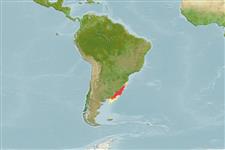Environment: milieu / climate zone / depth range / distribution range
Ökologie
seewasser; süßwasser; brackwasser. Subtropical; 23°S - 42°S, 63°W - 44°W
South America: southern Brazil, Argentina and Uruguay.
Length at first maturity / Size / Gewicht / Alter
Maturity: Lm 16.1 range ? - ? cm
Max length : 42.1 cm TL Männchen/unbestimmt; (Ref. 39376)
Rückenflossenstacheln (insgesamt): 6; Rückenflossenweichstrahlen (insgesamt): 9; Afterflossenstacheln 1; Afterflossenweichstrahlen: 19
Dyer, B.S., 1998. Phylogenetic systematics and historical biogeography of the neotropical silverside family Atherinopsidae (Teleostei: Atheriniformes). p. 519-536. In L.R. Malabarba, R.E. Reis, R.P. Vari, Z.M.S. Lucena and C.A.S. Lucena (eds.) Phylogeny and classification of neotropical fishes. Porto Alegre: EDIPUCRS. (Ref. 33128)
IUCN Rote Liste Status (Ref. 130435)
Bedrohung für Menschen
Harmless
Nutzung durch Menschen
Fischereien: nicht kommerziell
Mehr Information
ReferenzenAquakulturAquakultur ProfilZuchtlinienGenetikElectrophoresesVererbbarkeitKrankheitenVerarbeitungNutrientsMass conversion
PartnerBilderStamps, Coins Misc.LauteCiguateraGeschwindigkeitSchwimmstilKiemenoberflächeOtolithsGehirngrößeSehfähigkeit
Tools
Zusatzinformationen
Download XML
Internet Quellen
Estimates based on models
Preferred temperature (Ref.
123201): 12.1 - 19.6, mean 15.9 °C (based on 110 cells).
Phylogenetic diversity index (Ref.
82804): PD
50 = 0.5000 [Uniqueness, from 0.5 = low to 2.0 = high].
Bayesian length-weight: a=0.00575 (0.00335 - 0.00989), b=3.02 (2.87 - 3.17), in cm total length, based on LWR estimates for this species & (Sub)family-body (Ref.
93245).
Trophic level (Ref.
69278): 3.7 ±0.3 se; based on size and trophs of closest relatives
Widerstandsfähigkeit (Ref.
120179): mittel, Verdopplung der Population dauert 1,4 - 4,4 Jahre. (Preliminary K or Fecundity.).
Fishing Vulnerability (Ref.
59153): Low to moderate vulnerability (32 of 100).
